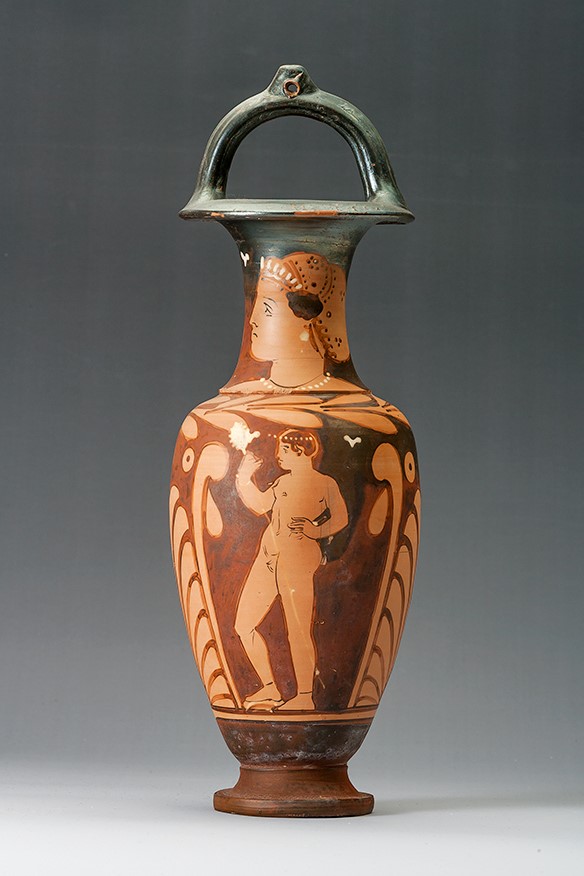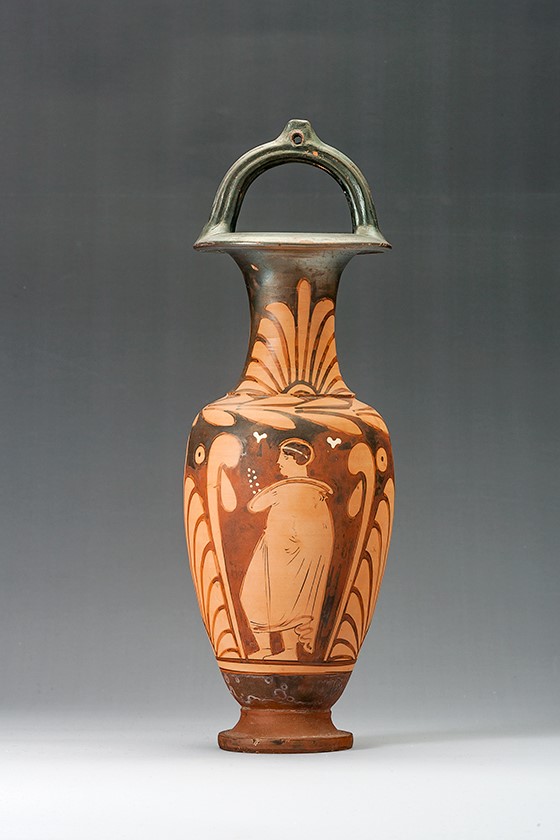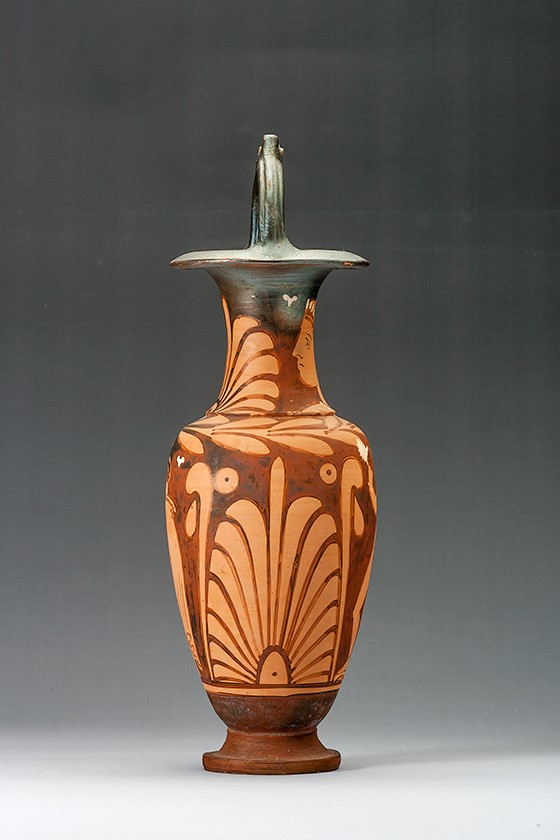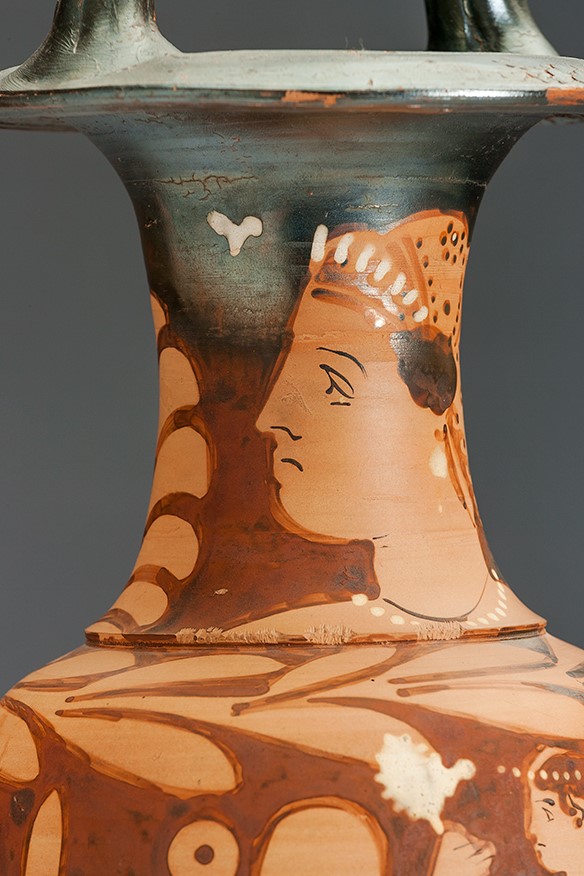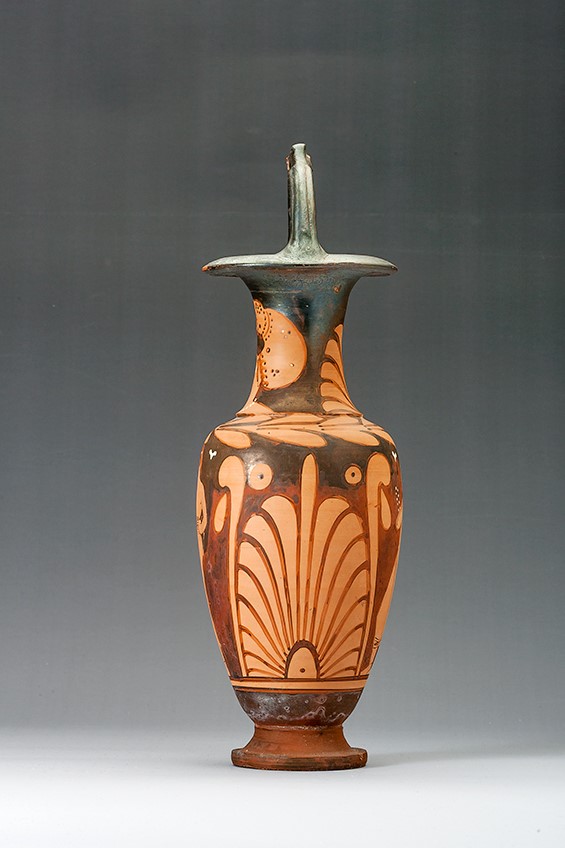Acquisition number: 1965.17
A: On the body, a young satyr with thyrsos. White was added for the thyrsos and the satyr’s tail, for the wreath about his head and the flower in the field to the right. On the neck, a female head. White was added for the dots of the necklace, the dots decorating the sakkos about her head, the stephane or tiara above the forehead, and the flower in the field to the left.
B: On the body, a draped youth holding a spray. White was added for the dots of the spray and the flowers in the field. On the neck, a palmette.
Between the scenes, palmette designs. The underside of the floor is reserved, protected by the air pressure when the lower part of the vase was dipped in the glaze solution (as a quicker alternative to brushing). There is no wash inside.
Title: Bail-Amphora - 1965.17
Acquisition number: 1965.17
Attribution: Caivano Painter.
Author or editor: J.R. Green
Culture or period: Campanian Red-Figure.
Date: c. 330 BC.
Material: Clay - Terracotta
Object type: Pottery - Red-figure
Dimensions: 132mm (w) × 323mm (h)
Origin region or location: Italy
Origin city: Campania.
Display case or on loan: 8
Keywords: Campanian, Red Figure, Satyr, Caivano Painter
Catalogo della importante raccolta archeologica degli eredi del Barone Gaspare Giudice di Agrigento (Sale Cat., Rome 1957) no. 318; A.D. Trendall, The Red-figured Vases of Lucania, Campania and Sicily i-ii (Oxford 1967) 312 no. 628, pl. 123, 7; J.R. Green with B. Rawson, Catalogue of Antiquities in the Australian National University, A.N.U. (Canberra, 1981) 66-67.
1965.17
Bail-Amphora
Purchased. Formerly in the Giudice collection, Agrigento. Ht (lip) 32.3cm; diam. 13.2cm.
Intact and in good condition. The glaze has misfired brown about the lower part of the vase: the metallic grey-black about the mouth and handle is more characteristic.
A: On the body, a young satyr with thyrsos. White was added for the thyrsos and the satyr’s tail, for the wreath about his head and the flower in the field to the right. On the neck, a female head. White was added for the dots of the necklace, the dots decorating the sakkos about her head, the stephane or tiara above the forehead, and the flower in the field to the left.
B: On the body, a draped youth holding a spray. White was added for the dots of the spray and the flowers in the field. On the neck, a palmette.
Between the scenes, palmette designs. The underside of the floor is reserved, protected by the air pressure when the lower part of the vase was dipped in the glaze solution (as a quicker alternative to brushing). There is no wash inside.
About 330 BC. Attributed by Trendall to the Caivano Painter, one of a group of Campanian
painters with a strong influence on Paestan vase-painting: see A.D. Trendall, Paestan Pottery: A Study of the Red-figured vases of Paestum (London 1936) 84-91 and 126-7, The Red-Figured Vases of Paestum (British School at Rome 1987)388-390, and The Red-figured Vases of Lucania, Campania and Sicily i-ii (Oxford 1967) 296ff. and especially 305-313, with additions in The Red-figured Vases of Lucania, Campania and Sicily suppl. 1 (London 1970) 53-54 and suppl. 2 (London 1973) 200-201. The painter’s career runs from about 350-320 BC.
The bail-amphora was a popular shape in Campania (seeA.D. Trendall, The Red-figured Vases of Lucania, Campania and Sicily i-ii [Oxford 1967] 225) and the undemanding nature of its form seems to have appealed to the less adventurous vase-painters. Counterparts for the shape exist in later Attic black-figure (see, for instance, J. Boardman, Athenian Black Figure Vases. A Handbook (London 1974) fig. 266; J.H. Oakley, “Bail Oinochoai”, in: Judith M. Barringer and Jeffrey M. Hurwit (eds), Periklean Athens and its Legacy: Problems and Perspectives [Austin TX 2005] 13-27) but for the present, at least, no direct connexion between the Attic and the Campanian can be demonstrated and it is perhaps more likely that the Campanian had an independent derivation and development from metal prototypes (cf. Schmidt, Gnomon 42, 1970, 829ff.; Vickers, Burlington Magazine 97, 1975, 390). An example is depicted on a cup of the later part of the fifth century attributed to the Codrus Painter: London E 83, J.D. Beazley, Attic Red-Figure Vase-Painters (2nd ed., Oxford 1963) 1270, 19, Beazley Archive Pottery Database 217228, Mitteilungen des Deutschen Archäologischen Instituts, Athenische Abteilung 113, 1998, 199 fig. 3a. At the same time it is worth observing that the shape is occasionally found earlier, in Attic Geometric (Kerameikos i, pl. 1110, inv. 1306; compare also Hayes, Greek and Greek-Style Painted and Plain Pottery in the Royal Ontario Museum (Toronto 1992) 9 no. 12 for an example of about 700 bc that is probably non-Attic: Parian?). For some examples in metal, see Bulletin of the Metropolitan Museum of Art 43.2, 1985, 33 fig. 19 (Mertens); Eulimene 6-7, 2005-2006, 136 fig. 10 (Triantafyllides); Bollettino di Archeologia On Line,Speciale, 2010,12 fig. 8 (Treister).
Catalogo della importante raccolta archeologica degli eredi del Barone Gaspare Giudice di Agrigento (Sale Cat., Rome 1957) no. 318; A.D. Trendall, The Red-figured Vases of Lucania, Campania and Sicily i-ii (Oxford 1967) 312 no. 628, pl. 123, 7; J.R. Green with B. Rawson, Catalogue of Antiquities in the Australian National University, A.N.U. (Canberra, 1981) 66-67.
